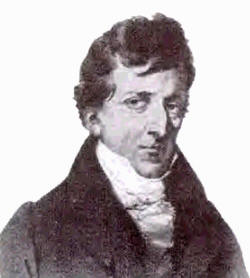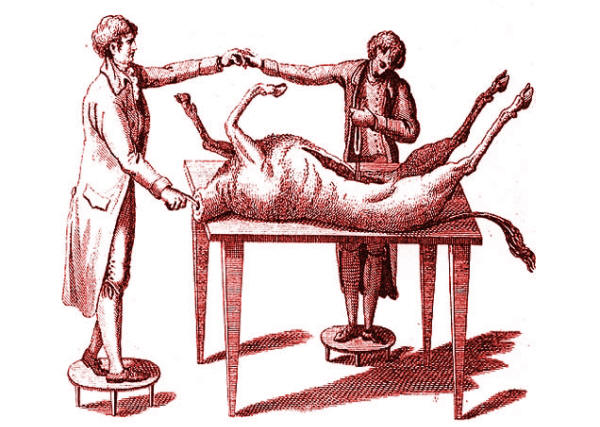Giovanni Aldini (1762 - 1834)
 Giovanni
Aldini was the nephew of Luigi Galvani. He became professor
of physics at Bologna in 1798, in succession to his teacher Sebastiano Canterzani
(1734-1819). His scientific work was chiefly concerned with galvanism and its medical
applications, with the construction and illumination of lighthouses, and with experiments
for preserving human life and material objects from destruction by fire.Giovanni
Aldini was the greatest of all Galvani’s supporters. He helped to organize
a society at Bologna to foster the practices of galvanism in opposition to a Volta
society established at the University of Pavia.
Giovanni
Aldini was the nephew of Luigi Galvani. He became professor
of physics at Bologna in 1798, in succession to his teacher Sebastiano Canterzani
(1734-1819). His scientific work was chiefly concerned with galvanism and its medical
applications, with the construction and illumination of lighthouses, and with experiments
for preserving human life and material objects from destruction by fire.Giovanni
Aldini was the greatest of all Galvani’s supporters. He helped to organize
a society at Bologna to foster the practices of galvanism in opposition to a Volta
society established at the University of Pavia.
Aldini traveled all over Europe publicly electrifying human and animal bodies, and his performances were extraordinary theatrical spectacles. In 1802 Giovanni Aldini came to London with a spectacular demonstration. Such spectacles performed on humans (and ox heads) produced repeated, spasmodic movements of facial muscles, arms, and legs. He stimulated the heads and trunks of cows, horses, sheep and dogs. An eyewitness reported: "Aldini, after having cut off the head of a dog, makes the current of a strong battery go through it: the mere contact triggers really terrible convulsions. The jaws open, the teeth chatter, the eyes roll in their sockets; and if reason did not stop the fired imagination, one would almost believe that the animal is suffering and alive again".
Though a showman in many respects, Aldini was among the first to treat mentally ill patients with shocks to the brain, reporting complete electrical cures for a number of mental illnesses. These experiments were described in details in Aldini's book published in London in 1803 "An account of the late improvements in galvanism, with a series of curious and interesting experiments performed before the commissioners of the French National Institute, and repeated lately in the anatomical theaters of London, by John Aldini." It was an influential book on galvanism, that presented for the first time a series of experiments in which the principles of Volta and Galvani were used together. The fine series of plates illustrated the experiments which involved bodies and heads of animals and humans. For the first time a description appears here of the magnetization of steel needles through connection to a voltaic circuit.

The most famous experiment took place at the Royal College of Surgeons in London in 1803, on a hanged man named George Forster. Anatomical dissection had formed part of Forster’s death sentence, but no one could have visualized quite the violation that Aldini was going to inflict on him. Before a large medical and general audience, he took a pair of conducting rods linked to a powerful battery, and touched the rods to various parts of the body in turn. The results were dramatic. When the rods were applied to Forster’s mouth and ear, “the jaw began to quiver, the adjoining muscles were horribly contorted, and the left eye actually opened.” When one rod was moved to touch the rectum, the whole body convulsed: indeed, the movements were “so much increased as almost to give an appearance of re-animation”.
And so it went on, with Aldini moving the two rods around the body in a different combinations like a switchboard operator. According to newspaper reports of the time, some of the spectators genuinely believed that the body was about to come to life, and were suitably awestruck even though it did not happen. But Aldini himself gave no indication that he expected any such thing – although he did describe his ultimate aim as learning how to “command the vital powers.” In practice, he confined himself to concluding that galvanism “exerted a considerable power over the nervous and muscular systems.” He also noted that nothing could be done with the heart.
In recognition of his merits, the emperor of Austria made him a knight of the Iron Crown and a councilor of state at Milan, where he died on the 17th of January 1834. He left by will a considerable sum to found a school of natural science for artisans at Bologna.

Connect with us
Contact us today